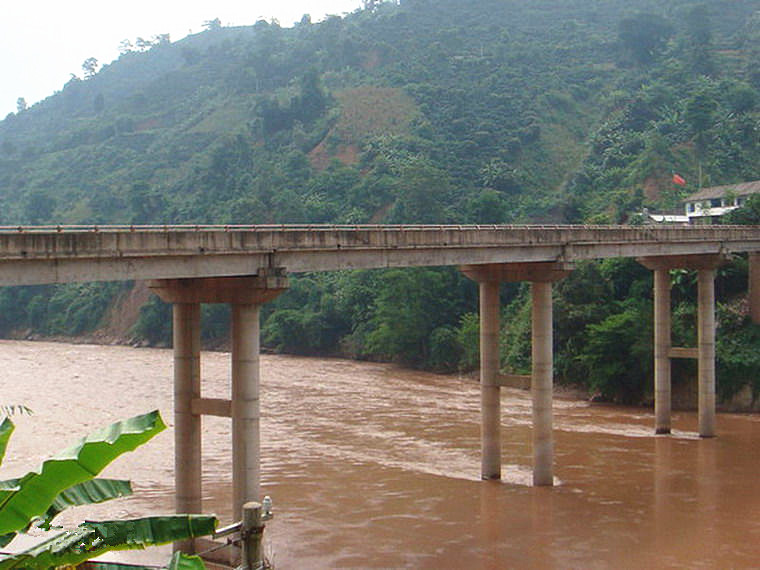
Amojiang River in Puer and Yuxi
Chinese Name:阿墨江
English Name: Amojiang River in Puer and Yuxi
The Amojiang River, a tributary of the Red River, is a primary tributary of the Lixian River. Its basin is located between latitudes 22°33′N and 24°35′N and longitudes 100°24′E and 102°22′E. The river originates in Maidi Village, Dajie Township, Jingdong County, Pu’er City, Yunnan Province. It flows through Jingdong, Zhenyuan, Xinping, and Mojiang Counties, with its upper reaches known as the Zhenggan River. After flowing southeast through Huashan, the river enters Zhenyuan County, where it is known as the Amojiang River after passing through Zhengdong. It then continues southeast, flowing through Zhongai Bridge and Puxi Bridge, before merging with the Talang River and Sinan River, turning south to eventually join the Lixian River.
Basin Overview:
The river’s total length is 256 km, with a drainage area of 7,029 square kilometers and a concentrated drop of 1,536 meters. The main river section from the source (elevation 1,500 meters) to the Zhongai Bridge dam site (low water level elevation 735 meters) is 166.47 km long, flowing through Jingdong, Zhenyuan, Xinping, and Mojiang Counties.
Development and Regulation:
The Amojiang River basin is designed for a total installed capacity of 468 MW. The first stage includes the Mansa Hydropower Station with an installed capacity of 60 MW, planned for later development. The second stage is the Zhongai Bridge Hydropower Station with an installed capacity of 110 MW. The third stage is the Puxi Bridge Hydropower Station with an installed capacity of 190 MW. The fourth stage is the Sanjiangkou Hydropower Station with an installed capacity of 108 MW. Zhongai Bridge and Puxi Bridge stations are designed as annual regulation reservoirs. The grading adjustment plan for Zhongai Bridge and the hydropower planning for Zhenggan River are being integrated. The entire Amojiang River basin is planned to have about 130 km of river sections with a concentrated drop of about 340 meters. It is expected that 4 to 5 hydropower stations will be distributed throughout the basin, with a total installed capacity of around 500 MW.
The Jufudu Hydropower Station is located at the confluence of the Amojiang River and the Baybian River. After reservoir filling, it has created a broad water surface over 10 km long. The reservoir area features deep bays with abundant fish resources, including species such as green carp, grass carp, silver carp, common carp, and tilapia. On sunny winter days, large fish often surface to bask in the sun, attracting numerous anglers.

 7 Days GolfingTour
7 Days GolfingTour
 8 Days Group Tour
8 Days Group Tour
 8 Days Yunnan Tour
8 Days Yunnan Tour
 7 Days Shangri La Hiking
7 Days Shangri La Hiking
 11 Days Yunnan Tour
11 Days Yunnan Tour
 6 Days Yuanyang Terraces
6 Days Yuanyang Terraces
 11 Days Yunnan Tour
11 Days Yunnan Tour
 8 Days South Yunnan
8 Days South Yunnan
 7 Days Tea Tour
7 Days Tea Tour
 8 Days Muslim Tour
8 Days Muslim Tour
 12 Days Self-Driving
12 Days Self-Driving
 4 Days Haba Climbing
4 Days Haba Climbing
 Tiger Leaping Gorge
Tiger Leaping Gorge
 Stone Forest
Stone Forest
 Yunnan-Tibet
Yunnan-Tibet
 Hani Rice Terraces
Hani Rice Terraces
 Kunming
Kunming
 Lijiang
Lijiang
 Shangri-la
Shangri-la
 Dali
Dali
 XishuangBanna
XishuangBanna
 Honghe
Honghe
 Kunming
Kunming
 Lijiang
Lijiang
 Shangri-la
Shangri-la
 Yuanyang Rice Terraces
Yuanyang Rice Terraces
 Nujiang
Nujiang
 XishuangBanna
XishuangBanna
 Spring City Golf
Spring City Golf
 Snow Mountain Golf
Snow Mountain Golf
 Stone Mountain Golf
Stone Mountain Golf














